TOM GOMEZ February 27, 2023 All Feature Vehicles
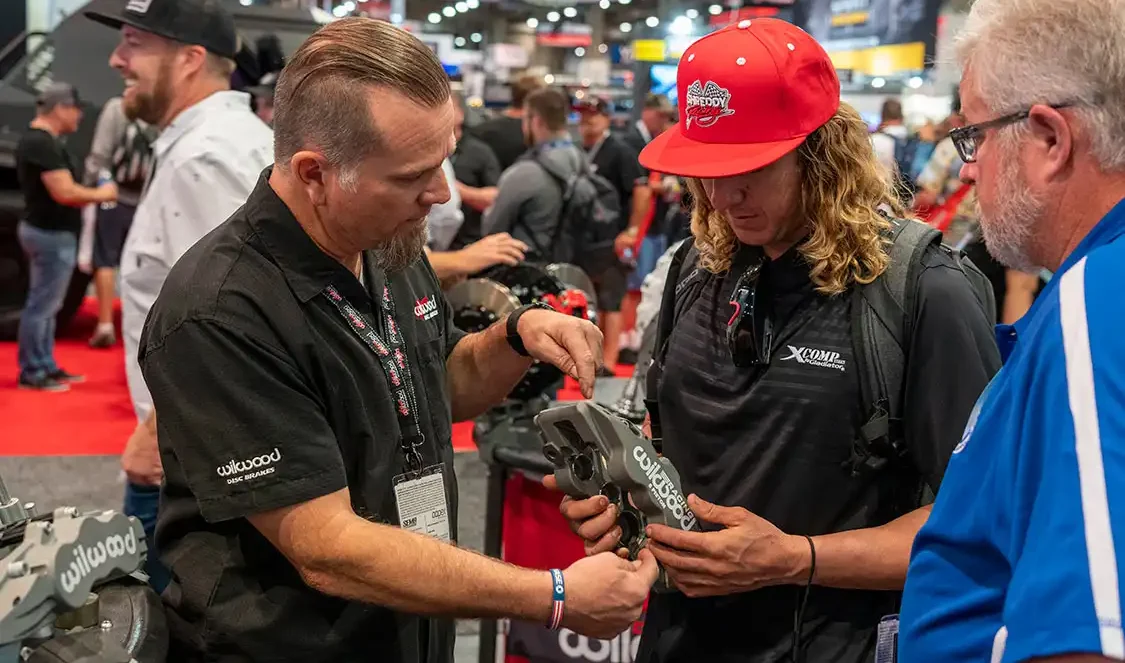
How many times have you attended a car, truck show and found your favorite manufacturer’s booth or trailer and your head is swirling with questions about their product and how it would work on your vehicle?
You approach the sales rep feeling confident and you’re ready to ask your question. Suddenly it’s your turn and stage fright takes over and you freeze up. You take a free sticker and walk away, your questions left unanswered.
If that doesn’t sound like you then you’re good to go and you’ll hopefully get more than a sticker. But for a lot of folks, it’s not that easy. Especially if you don’t know how a product works or the many choices that are available for your vehicle.
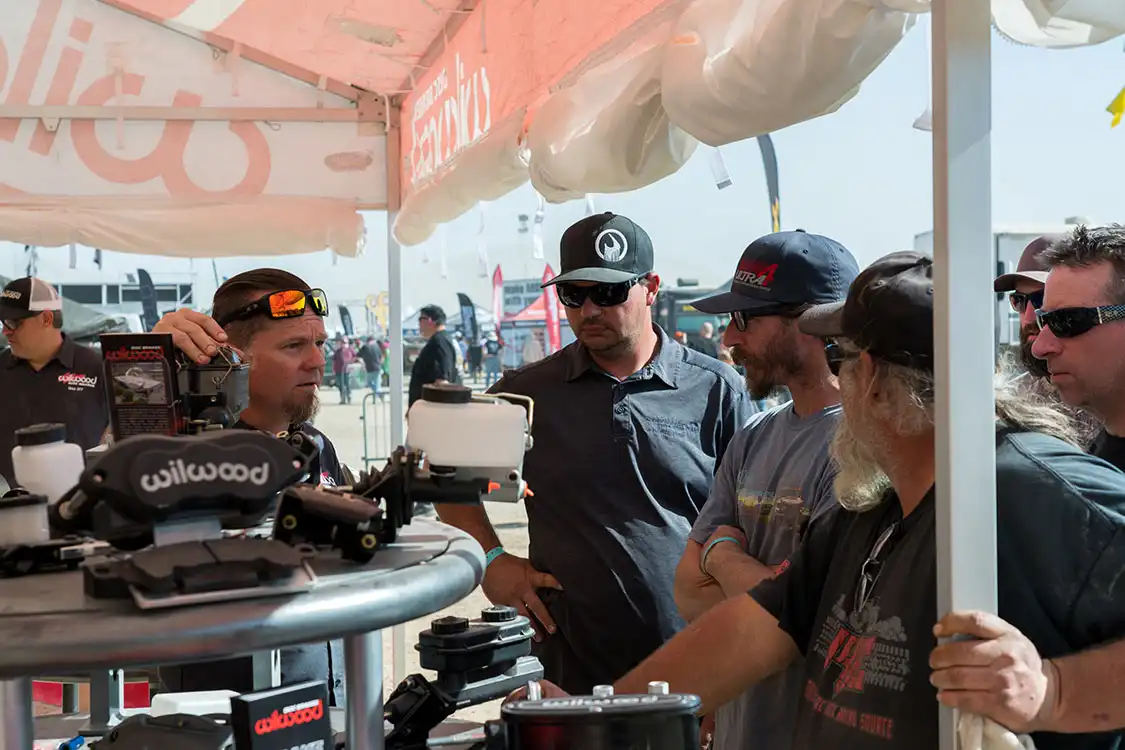
Remember when you were in grade school and the teacher would say, “There are no stupid questions.” But later that day, your dad says “what kind of stupid question is that?” Confusing and it leaves long-lasting memories.
Well, sit back folks, we’re about to teach you Manufacturer Row etiquette and how to get more than just a sticker.
DRIVE!: What if I don’t know what I’m looking for?
WILWOOD: Don’t forget, it is okay to say, “I don’t know.” Not everyone is the kind of gearhead that can pinpoint year, make, and model from a derelict bolt found in a parking lot. Not everyone gets elbows-deep into the engine bay or enjoys crawling under the car and getting dirty. Some people just like to drive a cool car and don’t worry too much about the specifics. Or they finally get the vintage car they’ve dreamed about since high school, only to find the performance pales in comparison to a minivan.
DRIVE!: What if I just want something that looks cool on my vehicle?
WILWOOD: The next fact you’ll want to convey, no matter what part you are shopping for, is how you will use the vehicle? Is this a race car? A weekend cruiser? A daily driver? A show car that you’d like to autocross on occasion? A drag racer that lives its life a quarter mile at a time? A rock crawler? A mall crawler? Be honest, and you’ll get more accurate answers. If you want it to look flash and don’t care if it goes fast, you’ll need different parts than if you are headed to the dry lakes and don’t care how good it looks as long as it flys.
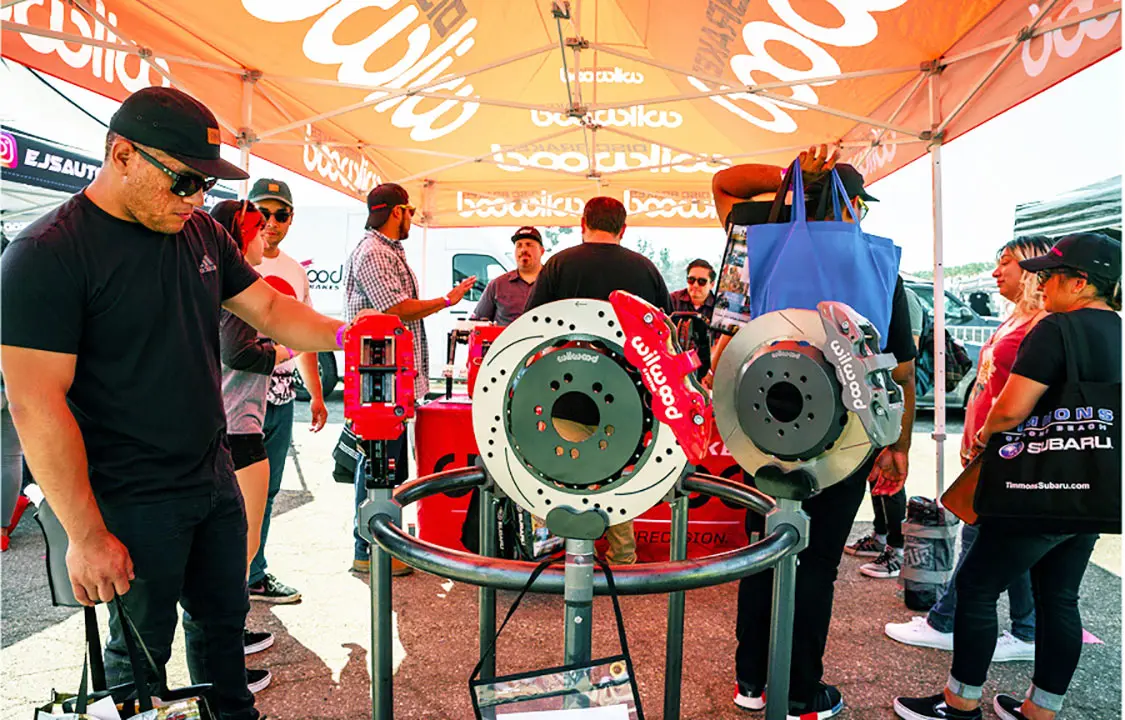
DRIVE!: Can I take pictures of the products on display for future reference?
WILWOOD: Take pictures, take notes, ask questions and listen to the answers you are given. The people in the booths at shows are there to sell their product, but they got into the business because of a love of cars/trucks/motorcycles just like you. Nobody is an expert at first, and every project is a journey that should start with as much information as possible.
DRIVE!: Can I buy products at the shows?
WILWOOD: In some cases, manufacturers will have products for sale or they can give promo codes for discounts to purchase through their distributors or online. If products are for sale at the booth generally they will give “Show” discounts and incentives like buy one get one free. Not everyone does this so you may have to inquire.
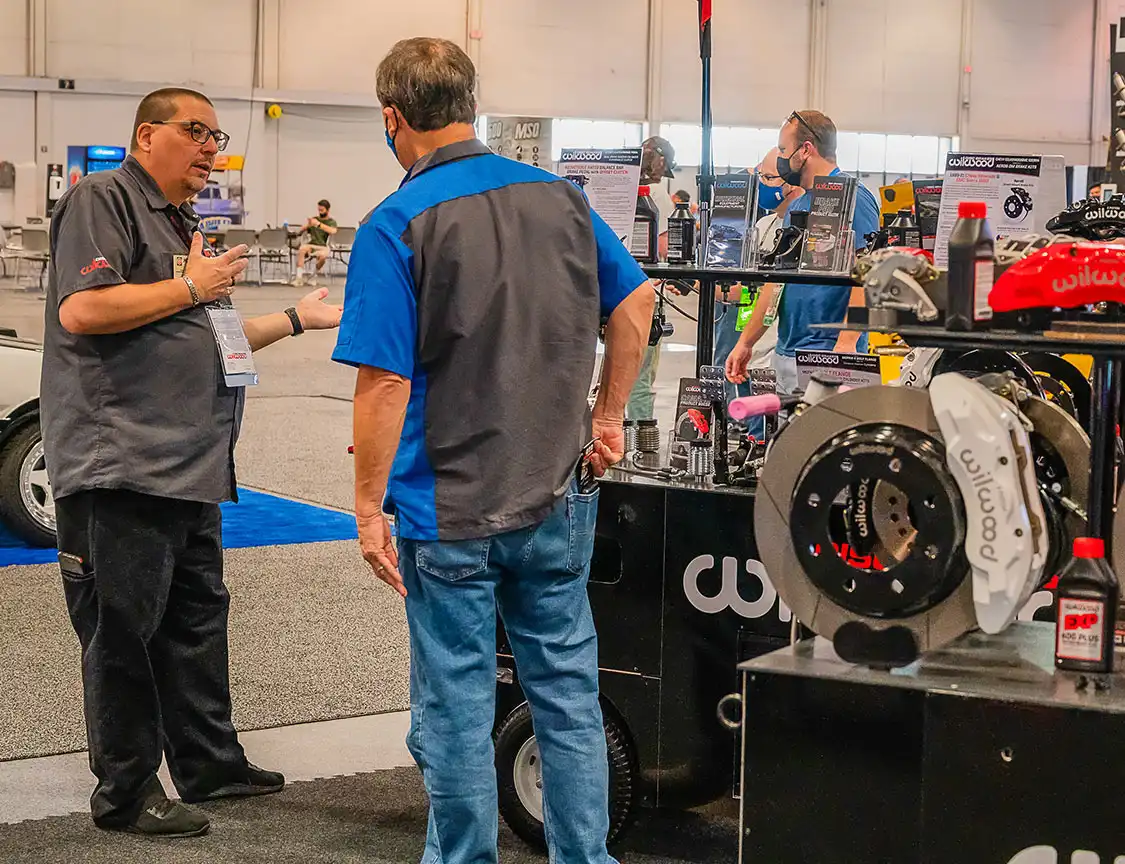
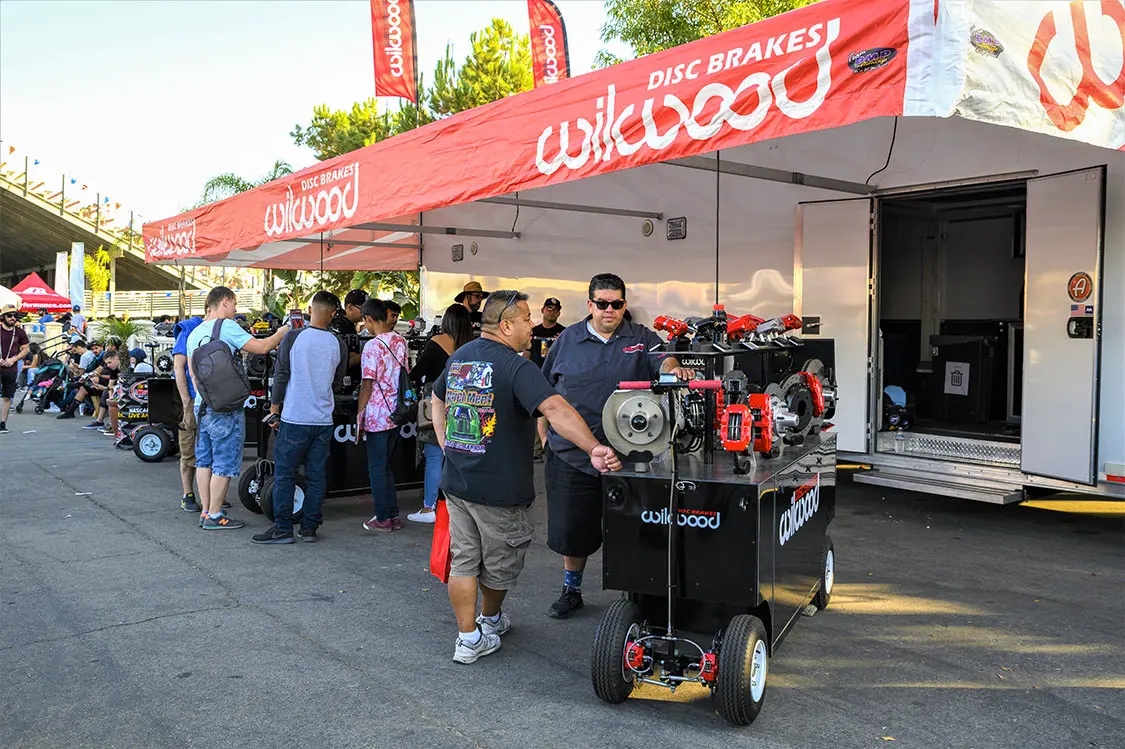
DRIVE!: Is there a car show etiquette to follow?
WILWOOD: There isn’t a written car show etiquette. It comes down to being respectful of others and the hardworking people at the booth. Remember these sales reps are standing on their feet for 8-10 hours a day talking to hundreds of people can be exhausting. We’re here to answer your questions and help you find the right application for your vehicle.
Just remember what your mom told you about your behavior in public and you should be fine.
The next time you’re at an event and you see the Wilwood display walk on over and say hi to Mike and the crew and remember there are no stupid questions unless you ask “What’s the meaning of life?” It’s a car show folks, just a car show. If it has anything to do with brakes we got you!
Oh, yeah, don’t forget your sticker.
The basics of brake pads and fluid
Wilwood knows the importance of giving the consumer the best information about their products for safety and performance.
With Part 2 of the Wilwood Answers Your Questions spotlight, we sat down with the experts at Wilwood and asked them the all-important question; “What kind of brake pads would I use and why are there different types of brake fluids?”
Both brake pads and brake fluid are consumables, which means you’ll need to change them throughout the ownership of your car. (What? You didn’t know you were supposed to change your brake fluid periodically?)
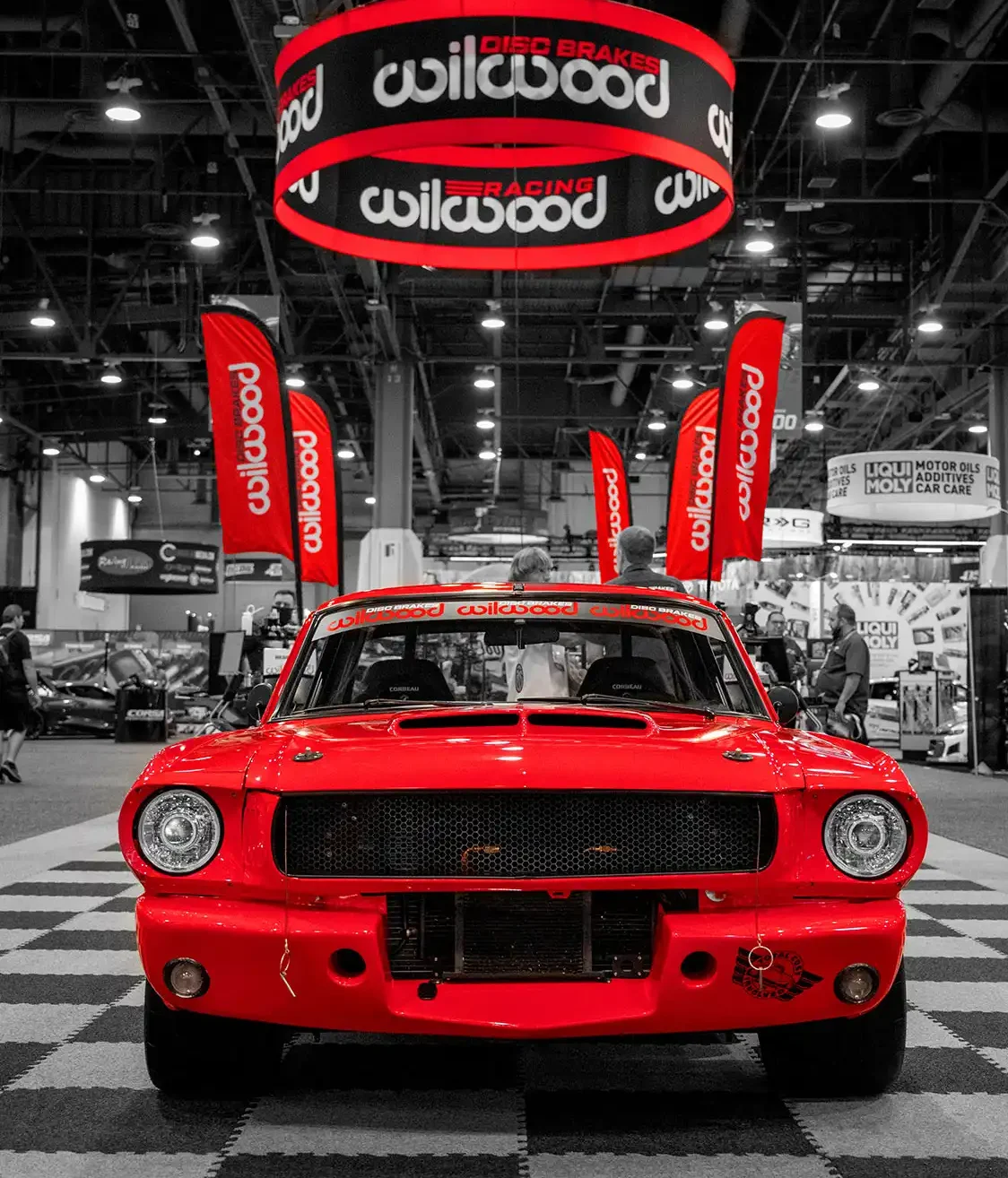
You may not realize it, but there can be a big difference in performance between the typical parts at your local store and performance pads and fluids sold by Wilwood and other brake specialists. Upgrading is usually as easy as installing new stock performance parts, and the improvements can be dramatic.
DRIVE!: Can I use high performance brake pads on my street driven daily driver?
WILWOOD: High-performance brake pads often have a more aggressive bite and don’t give up even in severe use as temperatures increase higher than normal. But, aggressive brake pads also tend to be harder on rotors and produce more dust, which is why the pad composition used on street cars is so different from the pads used by NASCAR.
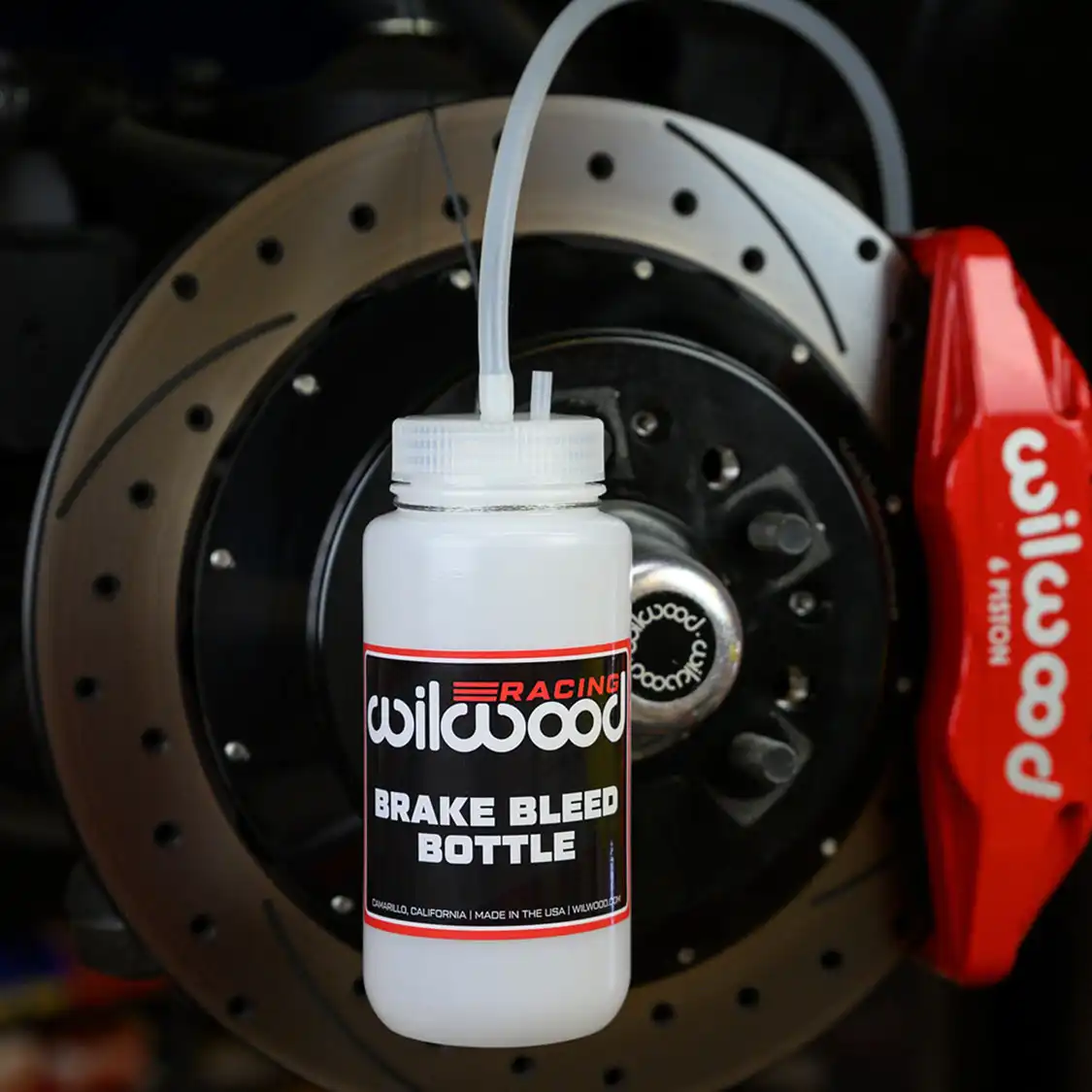
DRIVE!: What’s the difference between regular brake fluid and performance brake fluid?
WILWOOD: Brake fluids are more straightforward. Higher-performance brake fluids have a higher boiling point than standard fluids, with the downside being that they cost a bit more. Some performance fluids also have a greater affinity for absorbing moisture in the air, but that should be negligible if you change it every year or so and keep the system sealed like you are supposed to.
Even in the 21st century, brake pad formulation is an art as much as a science. The friction material on brake pads comprises many different parts held within binding agents to deliver the life, friction, heat resistance, dust, and noise expected. Add a little more carbon or steel, and the friction may increase – until you add too much, and friction suddenly decreases. Develop the perfect compromise of friction and wear, and it may not be legal for street use due to a high level of a metal like copper, which is a pollutant when the dust is washed into rivers.
In ordinary brake pads over the years, you might find aluminum oxide, iron oxide, quartz, silica, brass, carbon, ceramic, calcium carbonate, cashew nut tree oil, lime, rubber, coal, zinc oxide, phenolic resin, polyester, glass, aramid (Kevlar), and various other minerals, oxide and sulfide compounds. Before the 1990s, a large portion (more than 50%) of most organic brake pads was asbestos, which has been phased out in America due to cancer concerns. Until 2014, some brake pads contained copper, hexavalent chromium, lead, mercury, and cadmium, but those have been all but eliminated as well, as indicated by the Leafmark symbol on most brake pads today.
Brake pads consist of two basic parts – the backing plate and the friction material. In the early days, holes were drilled through both the friction material and the backplate, then attached with rivets. This is seldom done anymore because it weakens the backplate and lessens the friction material surface area. In the most common attachment method, the friction material is glued to the backplate, with some pressed through holes in the plate for added strength. With modern adhesives and friction material through the backplate, these plates will not come apart even with extreme use. Many high-performance pads are made by bonding the friction material to a backplate manufactured with hundreds of tiny hooks formed in it. This produces a pad that cannot break free from the backplate, and leaves the backplate with no weak points.
Wilwood makes brake pads in three different product lines and a multitude of compounds for various uses. ProMatrix is their performance OEM upgrade pad, with one compound good for street or light track use, in 155 different pad shapes to fit thousands of applications. PolyMatrix pads have been winning on race tracks for decades, with five compounds from A to Q, popular in circle track, road racing, off-road, drag racing, and street performance for Wilwood and many OEM calipers. SmartPad brake pads are their newest formulation, in four different compounds from BP-10 to BP-40, for street and competition use in Wilwood calipers.
ProMatrix – There is no downside to choosing the Wilwood ProMatrix equivalent instead of stock replacement pads for your street car; they perform better and only cost slightly more. They provide an excellent initial bite, even when cold, and don’t start to fade until over 1000 degrees. They have a smooth and predictable engagement, low noise, low dust, long pad life, and low rotor wear. There are better pads for hard track use, but the ProMatrix is okay for street, autocross, and light track days.
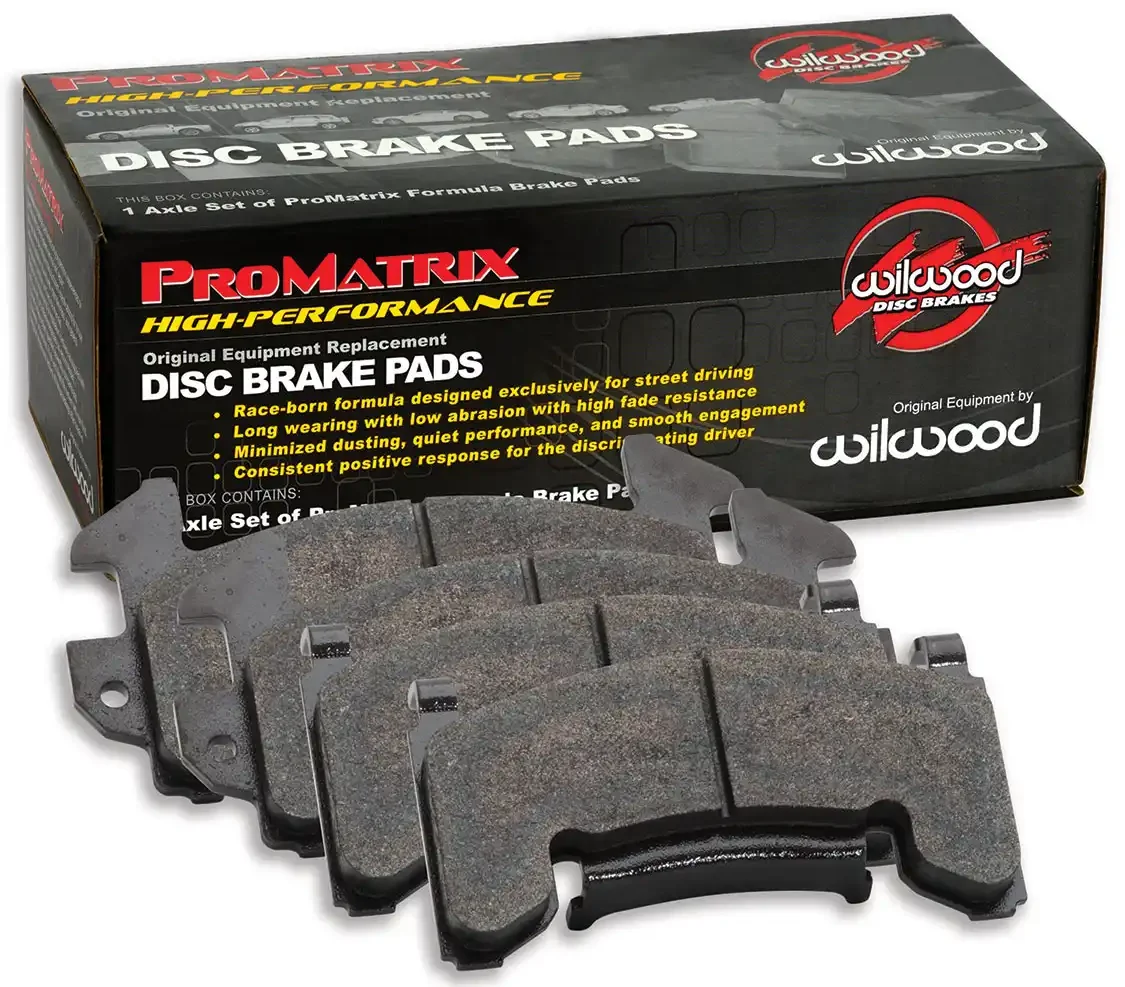
PolyMatrix – There are PolyMatrix compounds for everything from street cars to professional road racing. PolyMatrix A (race only) is a very aggressive bite pad with the highest friction rating and low wear for road racing, asphalt oval, and high-traction dirt track use with heavier or faster cars. PolyMatrix H (race only) has less aggressive bite and overall friction, making it easier to modulate for road race, asphalt oval, dirt, and other competition. PolyMatrix B (race only) has consistent high friction once heated without a hard bite for more confidence on low traction surfaces and sportsman oval track, road course, and off-road competition categories. PolyMatrix E (race only) gives a consistent, linear response through its full effective temperature range with less overall friction for higher-momentum tracks in dirt track, rally, autocross, and off-road, as well as drag racing. PolyMatrix Q is a street compound that is also friendly to aluminum rotors used in Sprint and Midget racing, ceramic enhanced for low noise and dust with good performance.
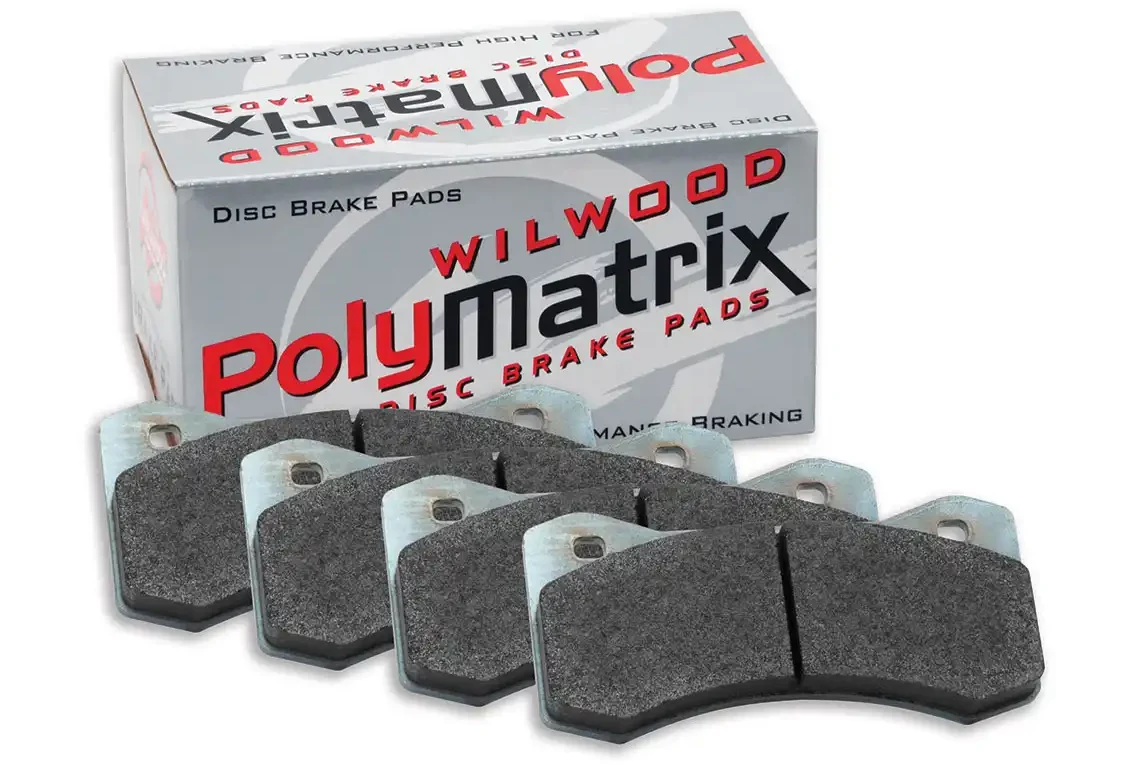
SmartPad – The latest compounds to come out of Wilwood’s testing are the SmartPad series, BP-10 to BP-40, going from least to most aggressive as the numbers climb. BP-10 comes standard in most brake kits and offers good street performance with low noise and dust, and is used in racing for low-traction surfaces, thanks to its gradual response and consistent friction as it gets hot. BP-20 is the usual upgrade for Wilwood truck kits and street kits used for track days with higher friction and a wider temperature envelope, and for dirt racing in tire-limited and all “hobby” classes. BP-30 (race only) is a long-wearing, high-friction compound for endurance racing with excellent modulation and feel, used in high-grip or downforce cars with extreme hard braking and sustained high heat. BP-40 (race only) is a very aggressive high-friction pad, but with excellent modulation for high-temperature, high-speed oval, road racing, and off-road.
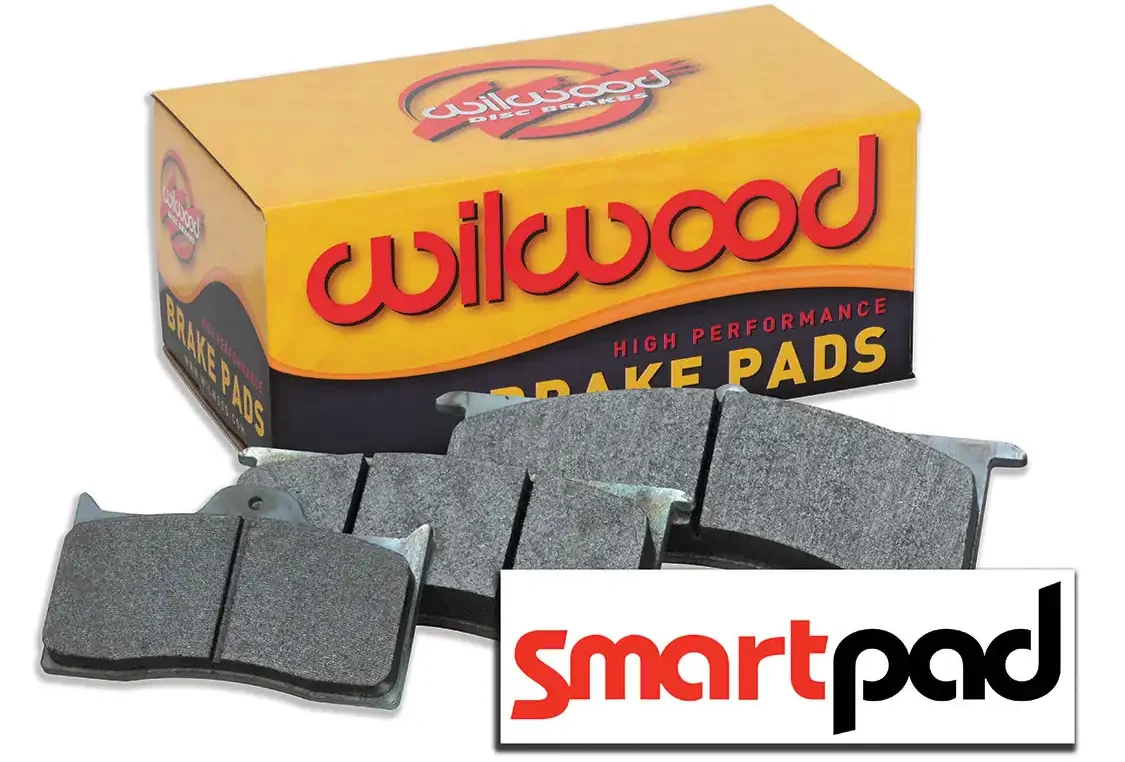
DRIVE!: How do I know which brake fluid is best for my vehicle?
WILWOOD: Brake fluid is an essential component of your vehicle’s brake system, and like the other vital fluids in your car, it degrades with time. This happens whether or not you drive your vehicle. A car sitting under a car cover in your driveway is still going to absorb moisture from the ambient air into the master cylinder and brake fluid.
The United States Department of Transportation (DOT) has set the standards used around the world for rating and identifying brake fluid. DOT 3 is the standard fluid most old cars were designed to use. All DOT 3, 4, and 5.1 fluids can be mixed without adverse effects, but silicone-based DOT 5 fluids are incompatible. Certain cars, especially modern vehicles with ABS brakes, may call for a lower viscosity DOT 4+ or DOT 5.1 ESP because it allows the system to react faster than thicker DOT 3 or DOT 4 fluids.
DOT 3, 4, and 5.1 brake fluid is glycol and borate ester-based, and with time will absorb moisture from the ambient atmosphere, even in your garage. Brake fluid is fully saturated with water when it has absorbed just 3.7%; that is less than half an ounce in a system with 12 ounces in it. For comparison, even at a dry 10% humidity, the air in a two-car garage contains more than six ounces of water.
You can lessen this absorption by wrapping the master cylinder and reservoir with plastic while the car is in storage. Fluid absorbed by the brake fluid can cause rust and corrosion of lines and calipers from the inside out, so flush the fluid every few years even if you aren’t driving it. Because brake fluid absorbs atmospheric moisture, even sitting on a shelf, you should only ever fill your master cylinder from a newly opened bottle. An unsealed bottle of fluid in a garage will degrade almost as quickly as fluid in your master cylinder.
More critical for performance cars is that fluid saturated with water boils at a temperature more than 100 degrees Fahrenheit lower than fresh, “dry” fluid. This shouldn’t be an issue for race cars, even those that race in the rain, because they flush the system with fresh fluid before each race. For the typical daily driver that may go years without a brake job or fluid flush, one twisty mountain road may be all it takes to overheat the brakes and boil the fluid.
When the fluid boils, you have no brakes!
One of the most critical considerations in high-performance applications is the brake fluid’s dry boiling point. The dry boiling point is the temperature that virgin non-contaminated fluid begins to boil. By DOT regulation, the minimum dry boiling point for DOT 3 is 401° F, and DOT 4 is 446° F. Special formulations are available from various manufacturers with much higher boiling points.
All Wilwood brake fluids exceed DOT dry boiling point standards. Hi-Temp° 570 is rated at 573° F, EXP 600 Plus is rated at 626° F, and XR Race-Only brake fluid at 645° F. Unlike performance and racing brake pads, which can make more noise and dust than street pads, there is no real downside to using brake fluid formulated for race cars on the street, except price.
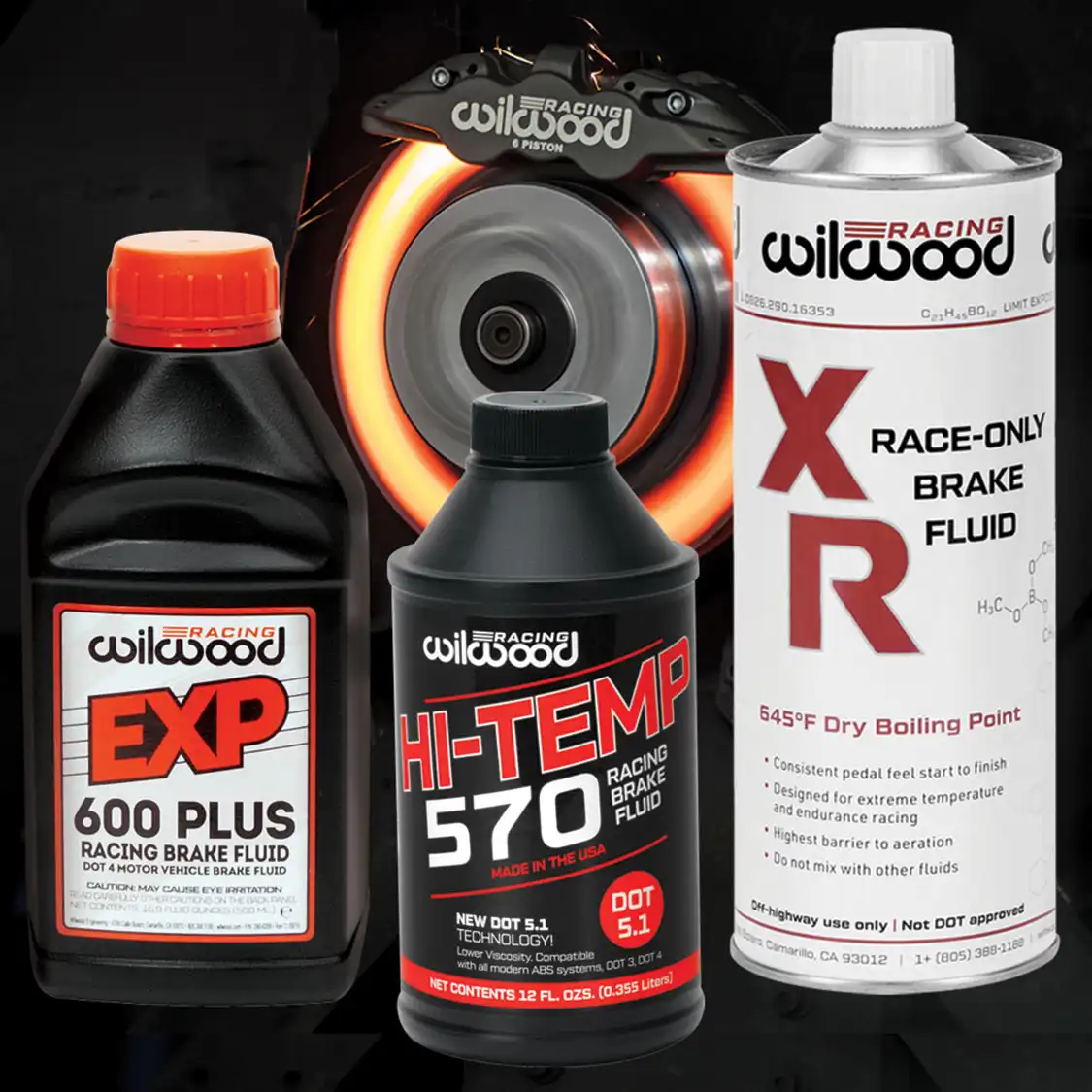
Hi-Temp° 570 – Not just a higher boiling point, this fluid has other advantages over off-the-shelf parts store fluids. Low viscosity and resistance to aeration and foaming make bleeding the air out of the system easier. Flushing your current system with Hi-Temp° 570 is a quick and easy upgrade to ensure your car can stop in the heat of competition or at the bottom of a mountain road. Originally DOT 3 rated, a new DOT 5.1 formulation is now available.
EXP 600 PLUS – This super-high temperature brake fluid was developed for predictable performance under the high heat and pressure of professional motorsports, on the track or off-road. EXP 600 PLUS fluid resists aeration and maintains low compressibility even after hundreds of heat and pressure cycles in a 500 lap stock car race. Wilwood EXP 600 PLUS fluid is fully DOT 4 approved, with stable viscosity and good lubricity no matter the temperature for reliability and performance, mile after mile.
XR Race-Only* – The same extreme high-temperature chemistry used in Formula 1, World Rally Championship, FIA World Endurance, and Moto GP. A proprietary blend of high-performance polymer electrolytes and borate esters gives it one of the highest boiling points on the market. This polyglycol-ether-based brake fluid combines the lowest compressibility, lowest moisture affinity, and highest resistance to aeration of any readily available brake fluid. XR Race-Only Brake Fluid is formulated to deliver the absolute best, most consistent pedal feel, start to finish, even in the most adverse racing conditions.
* For off-highway use only. Not DOT approved
DRIVE: Well, it’s time to put the brakes on for this portion of WILWOOD 101, and yes that pun was intended. We hope that you are better informed on the function and proper application of brake pads and brake fluids for your vehicle and as always remember, don’t be afraid to ask questions the savvy techs at Wilwood are happy to help you out. Find them online: wilwood.com
Wilwood has been in business for over 40 years and their brand is widely recognized, highly respected, and used without sponsorships by many winning teams, builders, and drivers. With that said, we’re pretty sure they know about brakes and all the components that are related to a performance brake system.
We had a chance to visit Wilwood at their huge facility in Camarillo, California. We met with marketing manager John Grieco and Michael Hamrick, Events and Promotions manager who you’ll probably see at the events because that’s what Mike does and has done that job for quite a long time. So he knows events!
We brought up the question about how they handle the many fans and their questions? They both smiled and said they look forward to the enthusiast’s interaction and questions. When they said, “There are no stupid questions. Ask us anything”. We knew this story would be fun and informative.
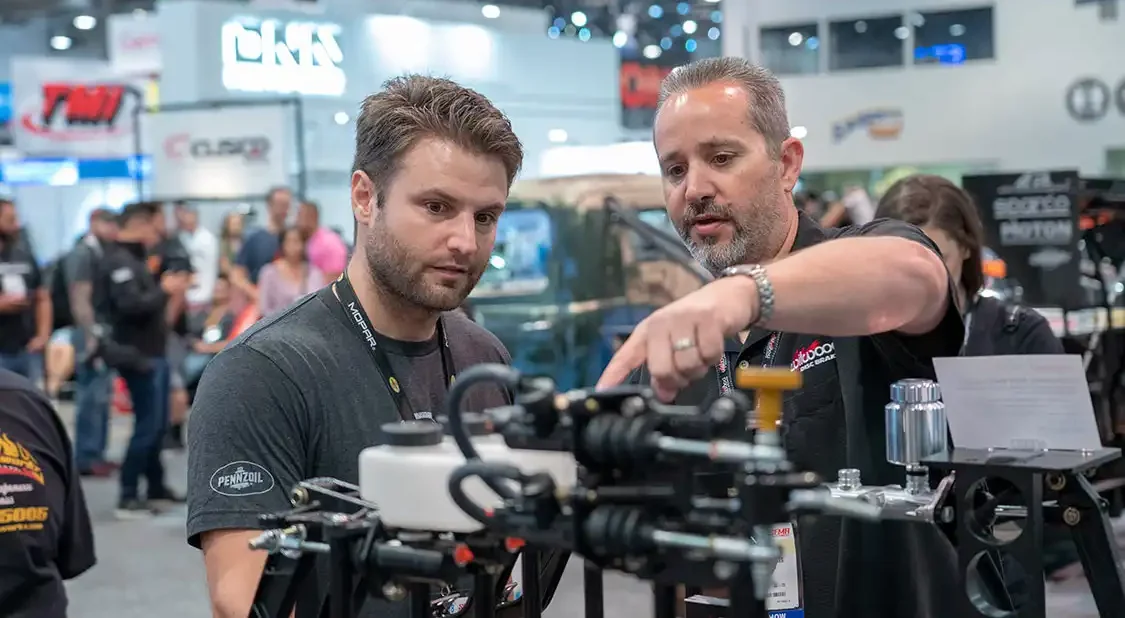
So we did. One key factor that we kinda knew the answer to, but was confirmed by both John and Mike, was the old saying “Bigger is better.” They replied, “Bigger is not better in the case of brake rotors and pads.” What? We’ll get into that in another article in a series that we will be doing with Wilwood over the coming months so stay tuned for that.
This article will focus on the fears people have when it comes to talking to automotive sales reps at trade or car shows.
Learn along with as the folks at Wilwood share with us how to get the answers you need.